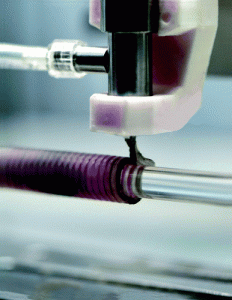Using a Combined 3D Printing Method to Create Stretchable Electronics
 Stretchable electronics have a lot of potential for applications in wearable devices, soft robotics, artificial skin and more. To create stretchable electronics, 3D printing is a fast, accurate technology that can built circuits and structures from liquid metal. Recently, researchers have been interested in stretchable electronics based on Ga-based liquid metals (GLMs), which are nontoxic liquids with low viscosity. Due to their high surface tension, however, GLMs are difficult to directly print. In a paper entitled “Three-Dimensional Coprinting of Liquid Metals for Directly Fabricating Stretchable Electronics,” a group of researchers develops a coprinting method in which GLMs are printed together with elastic materials to overcome their poor printability.
Stretchable electronics have a lot of potential for applications in wearable devices, soft robotics, artificial skin and more. To create stretchable electronics, 3D printing is a fast, accurate technology that can built circuits and structures from liquid metal. Recently, researchers have been interested in stretchable electronics based on Ga-based liquid metals (GLMs), which are nontoxic liquids with low viscosity. Due to their high surface tension, however, GLMs are difficult to directly print. In a paper entitled “Three-Dimensional Coprinting of Liquid Metals for Directly Fabricating Stretchable Electronics,” a group of researchers develops a coprinting method in which GLMs are printed together with elastic materials to overcome their poor printability.
The researchers used a coaxial nozzle for the process; the outer nozzle was used to extrude a flexible silicone material, while the inner nozzle extruded the liquid metal.
“The principle of this method is that the continuous contact and extrusion of the external highly viscous cure sealant with its internal liquid metal inhibits the balling of liquid metal, ensuring the continuous outflow of liquid metal and achieving the liquid metal 3D printing successfully,” the researchers explain. “At the same time, the flexible silicone material also plays an important role in isolating the air, preventing degradation of the liquid metal properties and being a flexible encapsulating material for flexible circuits. Appropriate process parameters are selected to ensure a successful printing process. Compared with other methods, this method can be used to quickly print desired structures with a programmed path.”
The core components of the system were a desktop 3D printer, the coaxial nozzle, and injection pumps.
“To fabricate the stretchable electronics, we performed the following steps,” the researchers continue. “First, the injection pumps extruded out GLMs into the inner blunt syringe needle of the nozzle at a suitable flow rate Q1 (above 0.25–0.75 mL/s) and extruded cure sealant into the outer cavity of the nozzle at a flow rate Q2 (above 2–4 μL/min) to make the coaxial fiber. Then, the G-code was input into the computer to control the XY stages of the desktop 3D printer to print the desired electronic circuit. What is more, the motorized Z stage can work with the XY stages to stack the planar electronic circuit into 3D structure. In addition, the motorized Z stage can be used to install other auxiliary devices for the construction of special 3D structures.”
The researchers used their technique to 3D print a spiral coil inductor. They then pasted both ends of the inductor onto the end effector of an endoscope to measure the spatial motion of the endoscope. When the handle was turned, the inductance of the sensor changed regularly. In addition, the inductive response of the sensor was highly sensitive, showing that the sensor has a good dynamic response and can be used to assess the idle stroke of endoscopic monitoring.
The problem with printing liquid metal is that it comes out as a ball rather than a stream; however, printing it so that it came in continuous contact with viscous elastic materials inhibited that balling. This allowed the researchers to 3D print stretchable electronic components that showed excellent performance when tested. According to the researchers, this is the first production of a new type of multifunctional stretchable inductance sensor.
“Compared with resistance sensors and capacitive sensors, inductance sensors are more reliable and have lower technological requirements because the detection performance of an inductance sensor only depends on the geometric parameters and turn numbers of a spiral pipe and is not affected by conductivity changes of liquid metal,” the researchers state.
Authors of the paper include Yong He, Luyu Zhou, Junfu Zhan, Qing Gao, Jianzhong Fu, Chaoqi Xie, Haiming Zhao, and Yu Liu.
Discuss this and other 3D printing topics at 3DPrintBoard.com or share your thoughts below.
Subscribe to Our Email Newsletter
Stay up-to-date on all the latest news from the 3D printing industry and receive information and offers from third party vendors.
Print Services
You May Also Like
New Business: Temporary, Migratory, & Modular 3D Printed Architecture
If we look at potentially emerging 3D printing businesses, then architecture has not been fully explored. Yes, there is a lot of house 3D printing going on worldwide. From deployable...
3D Printing News Briefs, April 19, 2025: Material Extrusion Standard, Metal Powder, & More
In today’s 3D Printing News Briefs, we’re covering a proposed standard for material extrusion, before moving on to business and metal powder. We’ll end with a commercial store’s robotic 3D...
Japan Unveils World’s First 3D Printed Train Station
Japan is now home to what we believe is the world’s first train station built with 3D printing technology. Located in Arida City, just south of Osaka, the new Hatsushima...
restor3d Raises $38M to Expand 3D Printed Orthopedic Implants
Backed by $38 million in new funding, restor3d is pushing ahead with the launch of four personalized implant lines, set to roll out in 2025 and 2026. This latest venture...



























